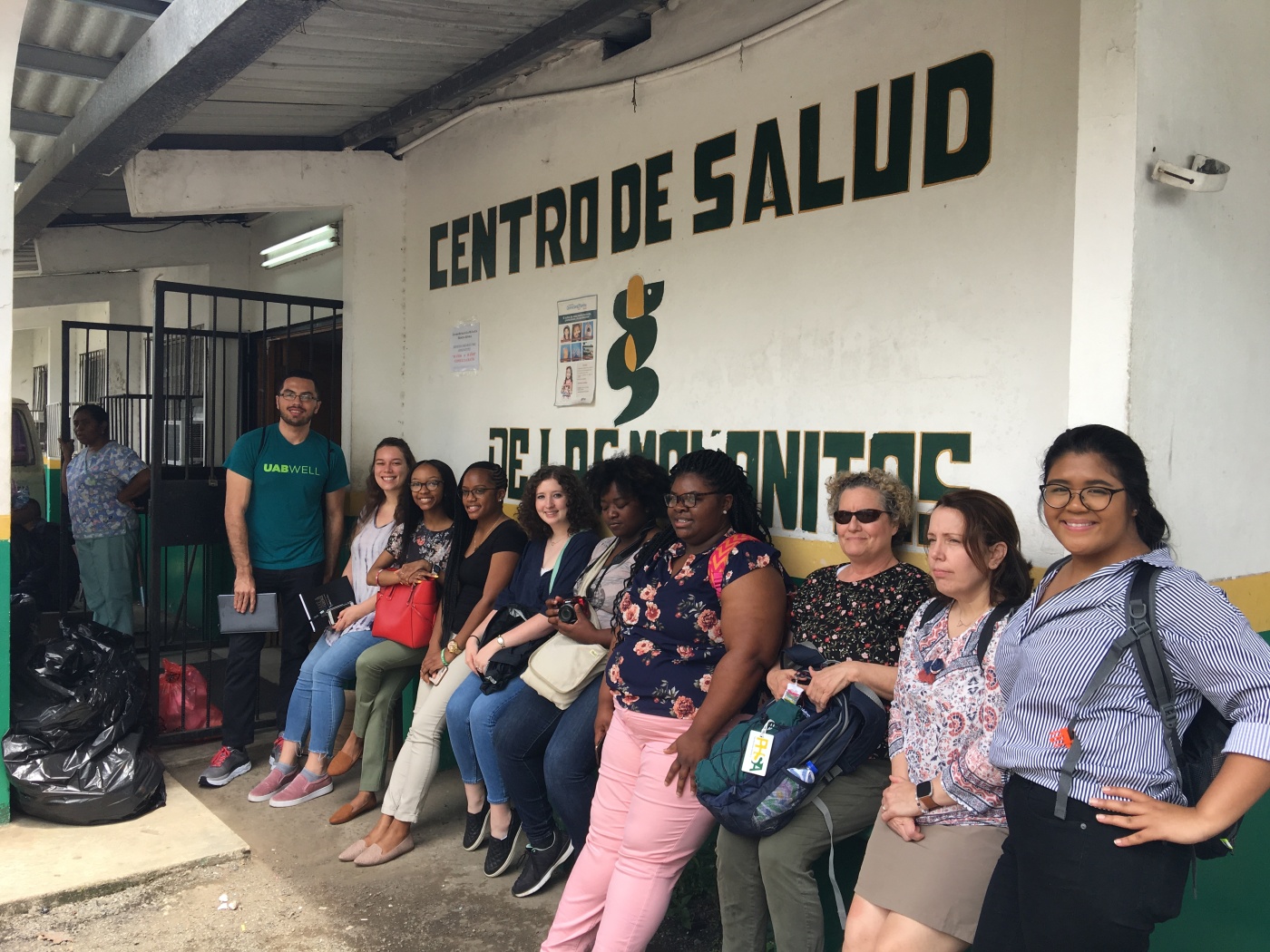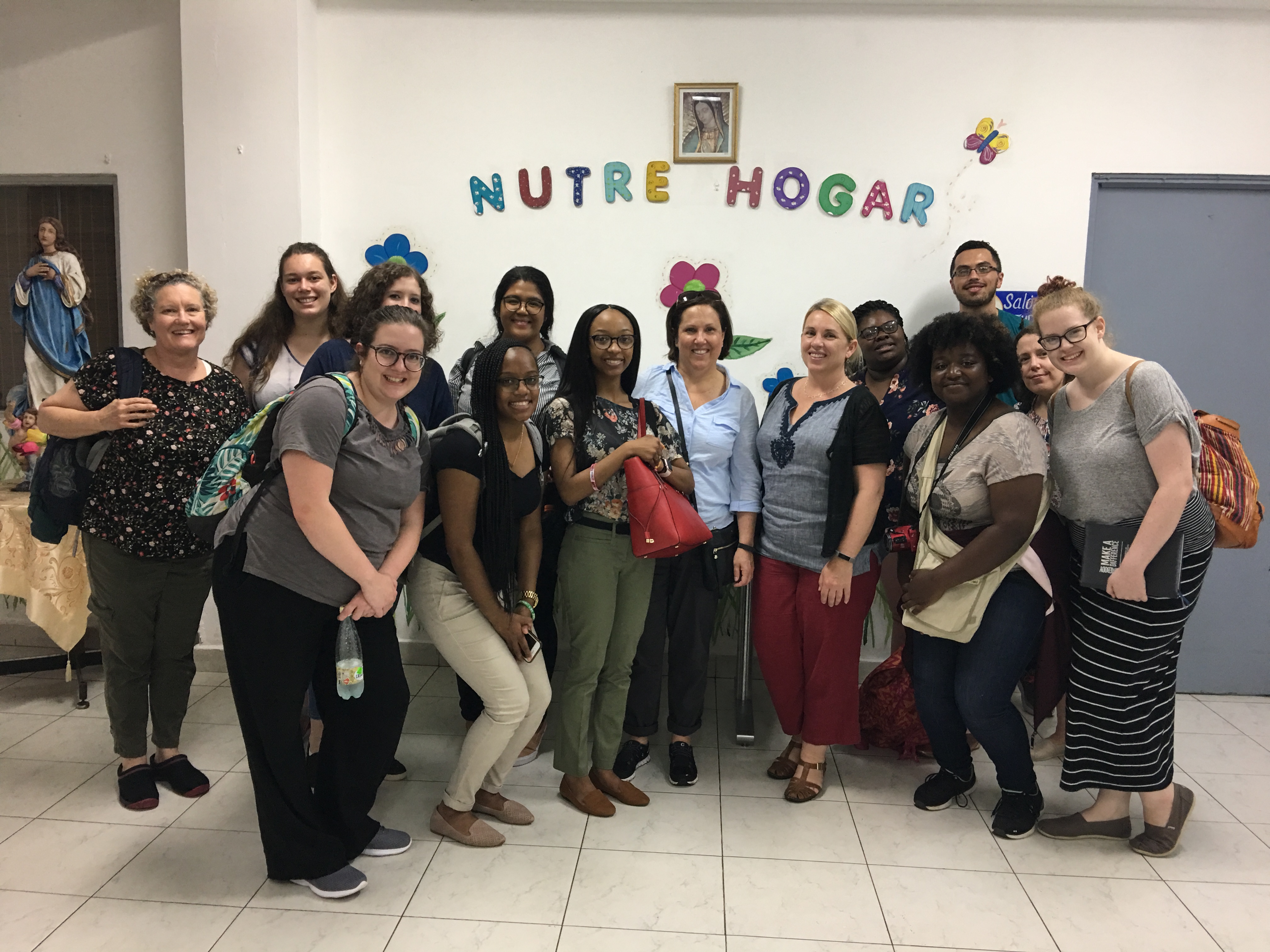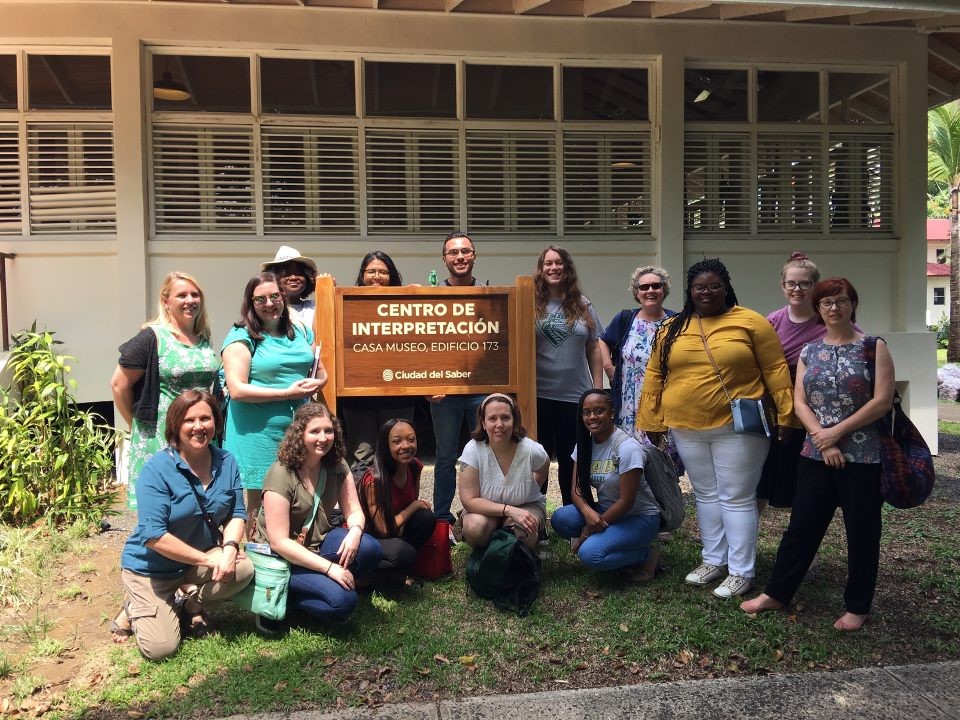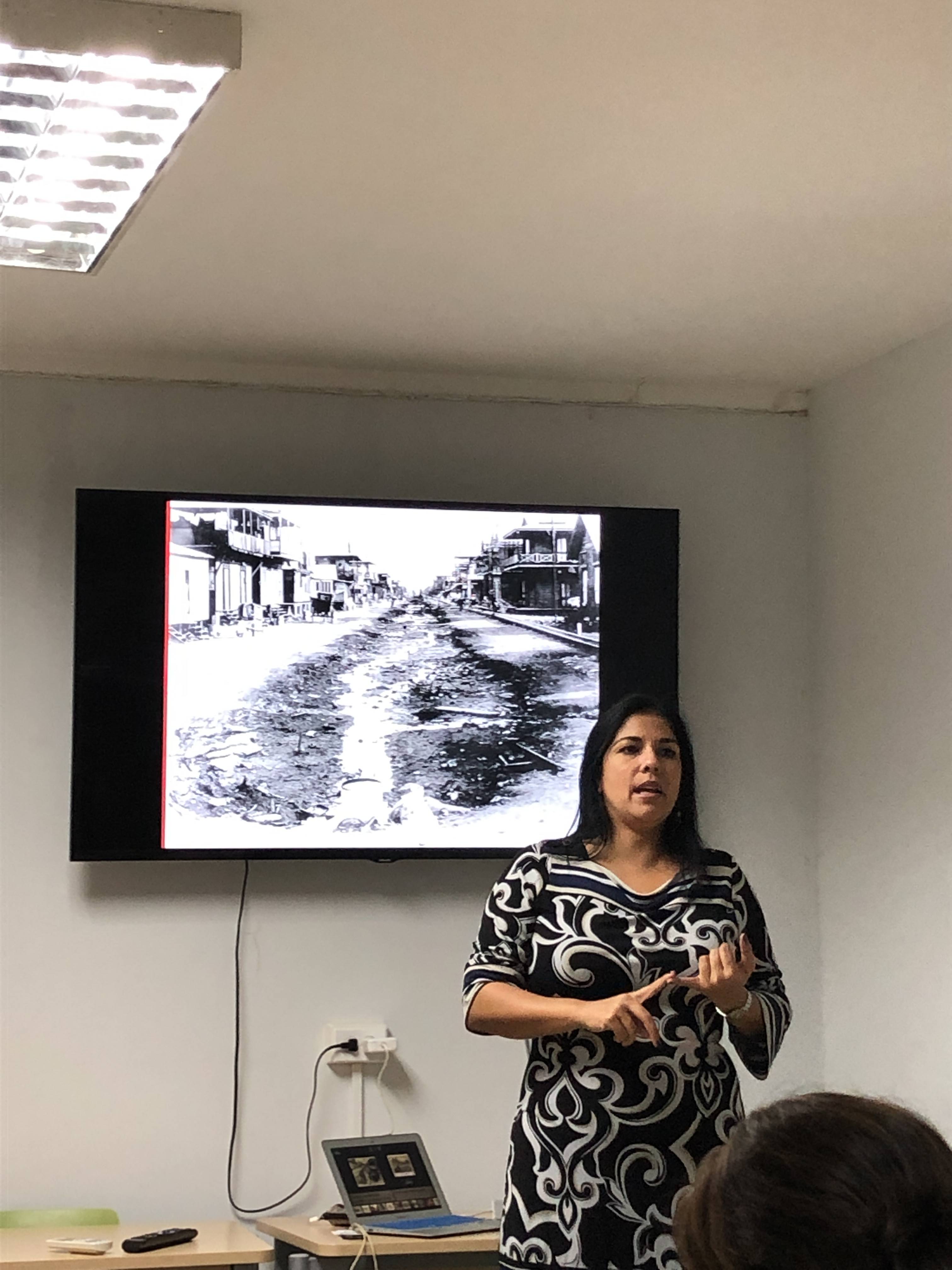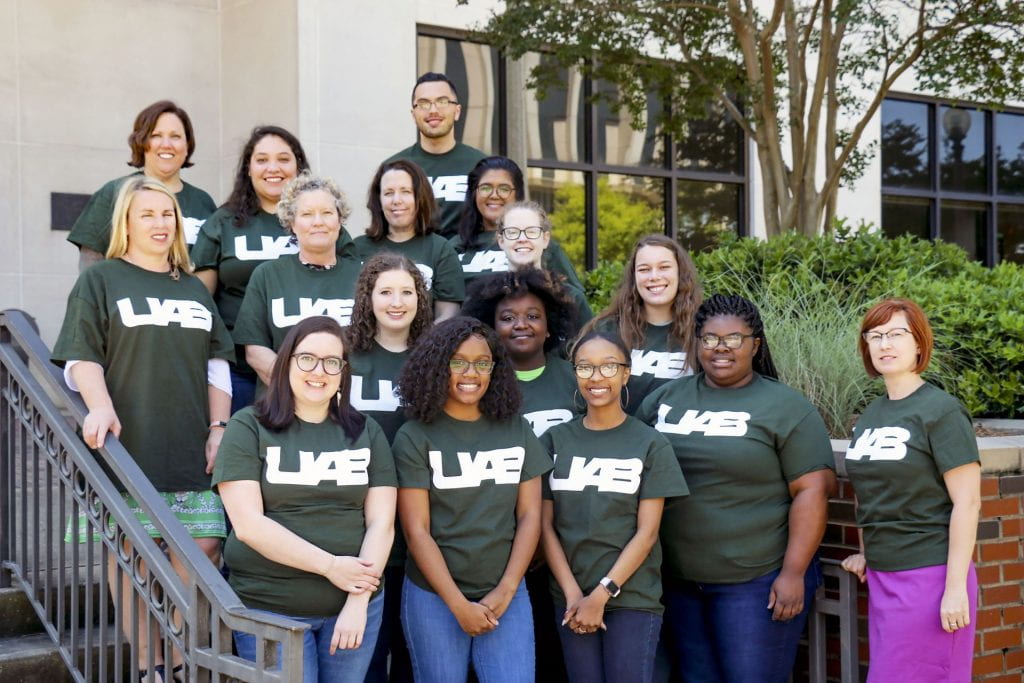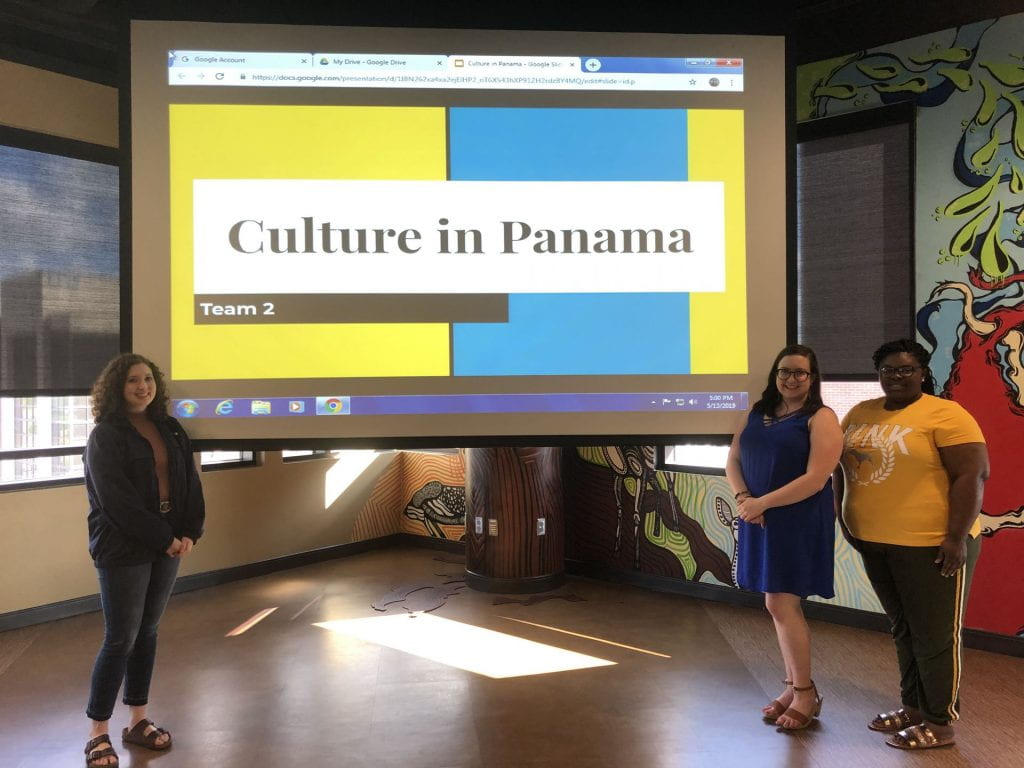
University of Panama Regional Center
To begin the day our group loaded the bus at 7:45 AM and made our way to the University of Panama Regional Center in Chitré. The University of Panama is the largest university system in the country with the main campus located in Panama City and 10 regional campuses throughout the country. Today we visited the regional campus of Centro Regional Universitario de Azuero based in Chitré. This campus offers a variety of majors and technical certificates in fields such as human resources, nursing, business, social work, engineering, and architecture to 3500 students.

Stepping off of our bus the street view of the university was fairly subdued. The entrance to the campus resembled a bus stop with white brick divider walls surrounded by an iron fence. After passing through the gate and walking down a few steps the University of Panama campus opened up into all of its hidden beauty. All of the academic buildings are surrounded by green spaces and the modest white bricks are embellished with inspirational quotes and murals. Pictured above is the building, which houses the office of the regional campus president, the site of our meeting for the morning. Leonardo E. Collado Trejos is the president of the regional campus in Chitré and was the main speaker during our meeting. Mr. Trejos is an incredibly welcoming man who exuded a genuine excitement to speak with us during our brief visit. During the meeting, Mr. Trejos described the history of the university and the opportunities and degrees offered. During the meeting we had the opportunity to meet with a handful of nursing/community health students and various professors. We learned that these students and professors have been conducting health assessments in communities outside of Chitré, and we will be joining them tomorrow as we visit these areas. After leaving Centro Regional Universitario de Azuero, our next stop for the day was the Ministry of Health Herrera Health Clinic in Chitré.

Herrera Health Clinic
Today we learned just how complex the Panamanian healthcare system is. Panama is divided into 13 provinces. Chitré is located in the province of Herrera, which is a relatively well-off province compared to the rest of the country. The Ministry of Health Herrera Health Clinic provides preventative care to the poorest citizens in the province. Most of the patients seen at this clinic include those that do not earn enough income to participate in the country’s social security health system or cannot afford the private system. Similar to the other Ministry of Health Clinic that we had visited, the Herrera clinic has a relatively modest exterior with the Ministry of Health insignia plastered above the entrance. Once inside the doors of the clinic the first thing that catches the eye is a huge mural of a woman breastfeeding her child directly above the reception desk.

The walls in the clinic are filled with intricately designed bulletin boards informing the public about heart health, fall avoidance, and services offered by the clinic. After a brief wait in the crowded lobby, our group toured the clinic with the chief nurse. She explained to us that all medical services are free or provided for a cost of one dollar. Of the free services a large majority are related to maternal and child health with all vaccinations, yearly check-ups, and prenatal care offered for free. Other services provided by the clinic, like routine dental visits, may require a small fee. During our tour the nurse described the general flow of the clinic as a patient may experience it. The clinic, similar to other Ministry of Health clinics, opens at 5:00 AM where it is common for long lines to be waiting at the door. Contrary to the US system, patrons can scan their “cédulad”, a Panamanian ID card, and enter their cell phone number to be called into the clinic closer to the time they will be seen. For more specialized services like dentistry or an appointment with the mental health provider, patients can book appointments in advance to avoid long lines and be guaranteed to be seen on a particular day.
This appointment system is crucial due to the incredibly low staffing in the clinic. On a typical day there are seven doctors, three dentists (one of which is a pediatric dentist), and a number of nurses and nursing assistants working in the clinic. We were told on an average day they have about 21 people working in the clinic. Each doctor sees about 25 patients a day, while nurses and nursing assistants, depending on their expertise, may see anywhere between 20-30 patients each day. The chief nurse estimated that they may see upwards of 400 patients each day in the clinic. She also shared that they are expecting a crowd of 1000 patients this next Thursday and Friday for a community clinic preventative program. They will have the same 21 healthcare workers staffing the day. The good thing is that these healthcare workers all seemed to love what they do and every nurse we met seemed vivacious and happy to speak with us. However, there was a common message throughout the day of the difficulty of having such a limited number of staff working in the clinic. During our time at the clinic it was easy to see that these healthcare providers were doing everything they could to care for the community but the number of people they can help with such a small workforce is limited.

Herrera Immunization Program – “En Panamá, no perdemos la oportunidad de vacunar (In Panama, we don’t miss an opportunity to vaccinate).”
After leaving the Herrera Health Clinic, we visited with the nurses who run the province’s immunization program at the Ministry of Health. Just like the immunization programs in the rest of the country, vaccination rates in the Herrera province are high, with some vaccination rates as high as 100%. The nurses explained that Panama has one of the best immunized populations in the world. In the Herrera Province, with a population of around 118,000, in 2018, 89% of the population was vaccinated for influenza. We were also told that 100% of all healthcare personnel in the country are up-to-date on all of their immunizations. As a comparison, in the United States during the 2017-2018 season, influenza vaccination coverage among healthcare professionals was only 78.4% as reported by the CDC.
The most surprising part of the presentation was that Panamanian immunization nurses travel to places where clinics are inaccessible and where community members lack transportation. They said they need to visit these people because receiving free vaccinations is a right for all, nationals and non-nationals. The nurses explained that if a child becomes sick with or dies from a preventable disease, the parent could face hefty fines or even jail time. There are laws in Panama that ensure a child’s right concerning access to vaccinations. If a parent refuses to vaccinate their child, their parental rights may be removed. Since 1997, Panamanian children have received comprehensive vaccines to guarantee their right to health, and this trend continues into adulthood. In Panama, the following vaccinations are available for the following age groups:
- Children 0-1 year old receive 5 shots: Hepatitis B, BCG, Conjugated pneumococcus, a 6-1 for DPT, Hib+Hepatitis B, Polio), the flu shot, and the rotavirus shot.
- Children 1-4 years old receive 7 shots: Pneumococcal conjugate, Triple Viral MMR, Hepatitis A, Varicella, Yellow Fever, Pneumococcal polysaccharide, Polio, inactivated polio, Tetravalente (DPT-Hib), DPT, and Influenza.
- Children 5-19 years old receive 9 shots: Poliol, inactivated polio, Hepatitis B, MMR, Conjugated pneumococcus, Pneumococcal polysaccharide, influenza, Tdap, papiloma virus. However, the HPV shots needs parental consent since it is administered in schools.
- Women 15-49 or of child-bearing age receive 3 shots: Tdap Adulto, MR, Influenza, Tdap.
- In addition to this, the general population receives 2 additional shots: Tdap for adults and varicella.
As a comparison, in the United States, the CDC recommends that vaccines are for those who meet age requirement, lack documentation of vaccination, or lack evidence of past infection. In Alabama, verification of vaccinations occurs at enrollment in daycares, some K-12 schools, and higher education institutions. Additionally, Alabama has medical and religious exemptions from vaccinations, which are not allowed in highly conservative Panama.

Providing Health Education at the Hipolito Perez Tello School:
As part of our time in Panama, our class was requested to visit the Hipolito Perez Tello School to provide health education sessions to kindergartners and 4th graders. Specifically, we were asked to cover personal hygiene topics with the younger students and to talk about vector control and vector borne diseases with the older students. Another reason for our visit was to give students of Hipolito Perez Tello the opportunity to interact with native English speakers so that they could practice the language.
Hipolito Perez Tello School serves roughly 900 children from an upper/middle class neighborhood in Chitré. As we entered the school grounds we were led through a beautiful courtyard, with a covered outdoor play area where children were playing ball. We were all a little nervous as this was the first time that many of us had interacted with a group of elementary age students. But our fears were quickly laid to rest when we were greeted by curious faces and vibrant hellos once we entered the classrooms.
In the weeks leading up to our arrival at Hipolito Perez Tello, we had prepared sessions for each grade and had been fortunate enough to secure donations to bring with us from the Alabama Department of Public Health, the Montgomery County (AL) Health Department, UAB’s School of Public Health, and UAB’s New Student Programs. We brought a variety of items to give the students including toothbrushes, toothpaste, floss, and dental hygiene activity books for the kindergartners, and backpacks stuffed with vector control activity books, colored pencils, and stickers.
Our group chose to work with one of the Kindergartner classes. When we entered the classroom, we were warmly greeted by the teacher and 20 or so students. Classroom walls were adorned with student artwork and, interestingly enough, reminded each of us of our time in elementary school. One of the UAB students in our group is fluent in Spanish, so we immediately began teaching the children the words for hands, washing, soap, water, teeth, toothbrush, paste, etc. in English. Miming washing our hands and brushing our teeth, the kids mimicked our movements and repeated words in English with such confidence that we almost forgot that English was not their first language. One young lady was so outspoken and smart, she had her fellow classmates quickly engaging with us. It is safe to say we learned a lot about communicating and interacting with children. Because of this experience, I think my group will be more confident as we begin to work in the community. In fact, before we left the school the children began sharing other personal hygiene tips with us including the importance of washing our face, eating well, and drinking plenty of milk. It was the best information received from the cutest experts ever.
Down the hall my fellow Blazers were teaching 4th graders about vectors (specifically mosquitos) and how to protect yourself from them. The kids in these classes were more than ready to answer the questions and enjoyed playing the game Mosquito Vector si o no?. Students competed for prizes as they answered questions posed to them about the topic.
What did we learn? These kids knew a lot more about these topics than we expected. We were surprised that they were able to communicate with us about the health topics in even more detail than we had anticipated. After our visit we learned that this particular school is consistently a top ranking public school in Panama. They have a respected and devoted principal and teachers who are doing their best to improve their students’ educational outcomes. We left the school energized and hopeful that the information we shared will be useful to the kids as they learn and grow.

Team 4: Panamá Special Viral Unit
Tim McWilliams (MD/MPH Student)
LeahGrace Simons (Graduate EPI Student)
Wilnadia Murrell (Public Health Undergrad)





